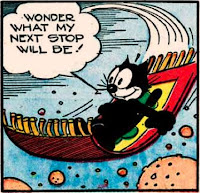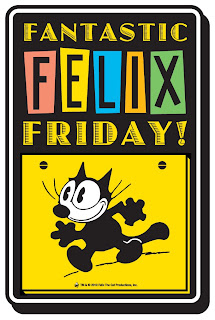 Rowr! It's been awhile since Felix the Cat prowled Ramapith's ivy-covered halls. But the feisty feline always comes back. This week I'm honored to help promote him in a new project for which I was a consulting researcher: Craig Yoe's and Don Oriolo's Felix the Cat: The Great Comic Book Tails. We're all calling today "Fantastic Felix Friday" and many of us collaborators are blogging about the book—time to do my bit.
Rowr! It's been awhile since Felix the Cat prowled Ramapith's ivy-covered halls. But the feisty feline always comes back. This week I'm honored to help promote him in a new project for which I was a consulting researcher: Craig Yoe's and Don Oriolo's Felix the Cat: The Great Comic Book Tails. We're all calling today "Fantastic Felix Friday" and many of us collaborators are blogging about the book—time to do my bit. Lots of us know Felix from his classic cartoons—both the vintage Otto Messmer head-trips of the 1920s and the famous Joe Oriolo Professor/Rock Bottom battles of the 1950s. Many of us know Felix's comic strip exploits, too—in which Otto and Joe again played central roles, drawing blissful dailies and Sundays for many a decade. But there's never been a really solid collection of Felix's comic book adventures. However—the times, they are a-changing! Thanks to both the Oriolo company archives and various collectors' holdings, Craig and Don (son of Joe) have put together this lavish, in-depth look at the first ten years of Felix made for magazines.
Lots of us know Felix from his classic cartoons—both the vintage Otto Messmer head-trips of the 1920s and the famous Joe Oriolo Professor/Rock Bottom battles of the 1950s. Many of us know Felix's comic strip exploits, too—in which Otto and Joe again played central roles, drawing blissful dailies and Sundays for many a decade. But there's never been a really solid collection of Felix's comic book adventures. However—the times, they are a-changing! Thanks to both the Oriolo company archives and various collectors' holdings, Craig and Don (son of Joe) have put together this lavish, in-depth look at the first ten years of Felix made for magazines. When Felix's original comic book stories kicked off in 1946, he wasn't quite the same cat that he'd been twenty years earlier on-screen. His catty resourcefulness remained, but in other ways he had become more human than feline. Felix lived in a house now; paid his bills (or tried to!) and generally coexisted with people as a peer, not a pet.
When Felix's original comic book stories kicked off in 1946, he wasn't quite the same cat that he'd been twenty years earlier on-screen. His catty resourcefulness remained, but in other ways he had become more human than feline. Felix lived in a house now; paid his bills (or tried to!) and generally coexisted with people as a peer, not a pet.But if Felix's animal nature had declined, his propensity for fantasy was wilder and woolier than ever before. This was the Felix who not only visited Toyland and various Oz-like domains—but permanently owned a magic carpet, enabling him to go back to them again and again. This was the Felix who discovered that when you cooked vegetables, giant vegetables would one day catch you and try to cook you, too.
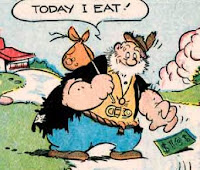 Eyes downward, readers, and you'll find "Starbust" (Four Color 135, 1946), the opening story in the new book. Dig that Art Deco star on Page 1—and don't you just love how this actually becomes a story about escaping the star? Nobody but Felix got into adventures this wacky. Nobody else dared.
Eyes downward, readers, and you'll find "Starbust" (Four Color 135, 1946), the opening story in the new book. Dig that Art Deco star on Page 1—and don't you just love how this actually becomes a story about escaping the star? Nobody but Felix got into adventures this wacky. Nobody else dared.Pages 1, 2, 4, 6, and 9-16 appear to me to be drawn by Otto Messmer, with inks mostly by Messmer but sometimes by Joe Oriolo (the extra-wide cut in Felix's pie-eye on Page 4, Pic 2 suggests Oriolo in this period, as do images of Felix with a round back to his head rather than the usual cowlick).
Pages 3 and 5 are by Jim Tyer—dig the classic Tyer bum and sheriff designs!—and 7 and 8 appear to me to be Messmer and Tyer working together.
But let's see what you think. Then join me after the jump for an even more special Felician feature... (Comic © Felix the Cat Productions, all rights reserved.)
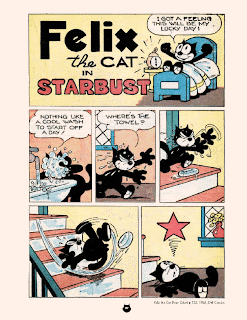
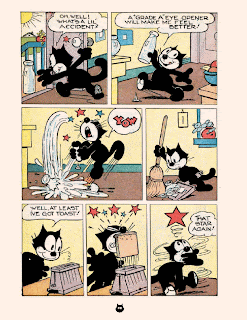
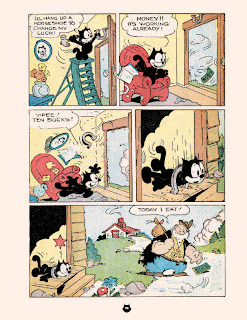

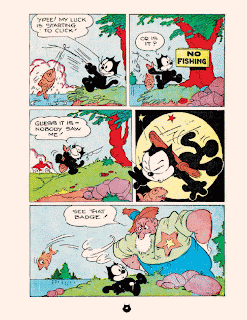
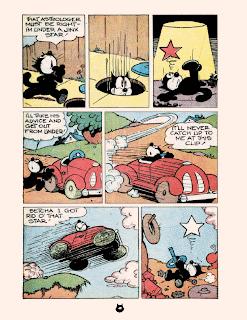
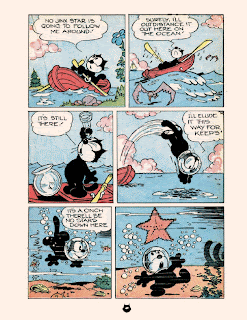
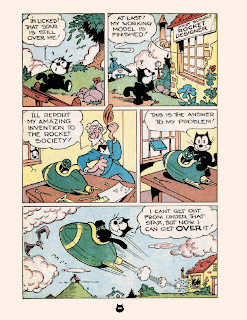
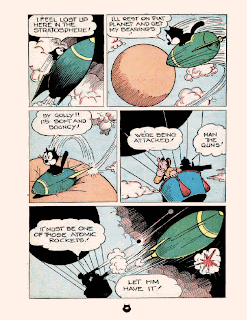
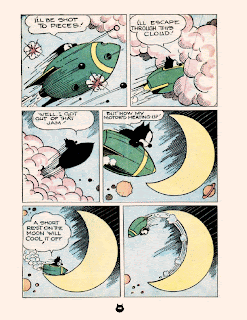
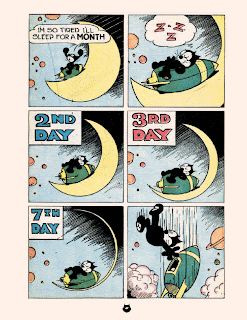
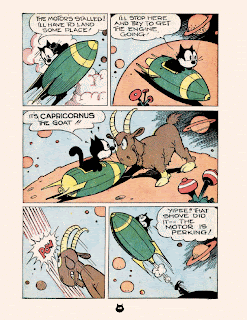



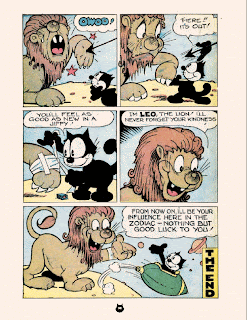
Welcome back. (Nice comic, huh?) I've got Don Oriolo with me today—son of Joe, Don began life scampering around his dad's and "Uncle Otto's" drawing boards; not a bad place to start out! I thought I'd interview Don for "Fantastic Felix Friday" to get some inside dope about the stories in Great Comic Book Tails—and about some other long-simmering Felix mysteries.
I'll switch to boldface for proper interview technique and let's get going!
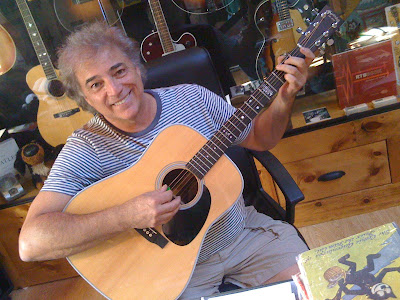
Glad to have you here, Don! Hm, where to begin? Most Felix comic book stories were drawn by Otto Messmer and your dad, Joe Oriolo. But for the first couple of years at Dell, super-screwy cartoonist Jim Tyer—best known for his distinctive, outrageous style at Terrytoons and Fleischer—was also a contributor. Did you meet Tyer when he worked with your dad? Did Joe or Otto have any special memories of him?
Hi, David... first of all, let me say it's always a pleasure to talk with you, and I'm continuously amazed at your knowledge of all things Felix. Yes; Jim, or Mr. Tyer as I called him, was one of the Fleischer guys that my father and Otto worked with during those wondrous Fleischer and Famous Studios days. My father loved to have barbecues, and the Fleischer "family" was always there. I know both my father and Otto admired Jim's talent. Jim also worked on a couple of Trans-Lux [Felix TV] episodes.The Felix stories in this book come from a transitional period when Felix's supporting cast was changing. We see Flub the dog, Inky and Winky, and Pokey the pig, but only in relatively brief parts. On the other hand, we also get a brief cameo from a crook who's clearly a Rock Bottom ancestor (in the story "Seeds and Proceeds"). When your dad added Rock and the Professor to the cast, how did it come about? They were almost never in the comics, so did Trans-Lux request that the cast be filled out especially for TV?
That's exactly how it happened. Trans Lux wanted more ancillary characters... so my father reached back to Butch who became Rock Bottom.
You mean Butch the bully from the 1950s-era newspaper strips, right?
Yes. Butch was sort of a predecessor of Rock... minor changes, of course. "Rock Bottom" was a name that just popped out of my father's head; a typical punnish play on words that the Popeye guys always toyed with. Poindexter was the last name of my father's lawyer, Emmett Poindexter. Pokey the pig was also called Starvin' Marvin...
The Professor was an an amalgam of various "professorial" characters that appeared in the comics and strips through the years. I think one of the most brilliant off-the-cuff design concepts was the button on Poindexter's lab coat... I always asked my father what that button did, and I always got the runaround. I think he only used it a couple of times in the series.Many of the Great Comic Book Tails show Felix with his Magic Carpet—and a very unmagic travel bag. Your dad made the decision to combine them, creating the famous Magic Bag. But had the Carpet been your dad's creation too? What motivated the decision to change two into one?
Yes, it was my father's. My father was fascinated with the Arabian Nights and The Thief of Bagdad (1940). He would always tell me, my brother and sister stories of flying carpets and time machines. I was always imagining that one of the Persian rugs in our house could fly me anywhere in the universe—and in my playtime imagination, it did. The Magic Bag was an element created to give an easy way out in the five-minute [TV] episodes... it replaced the piercing of the fourth wall in simpler terms for a series with such a limited budget.
Felix's Carpet was this big, clunky looking thing...
It was the way both my dad and Otto drew rugs—tassels and all. Those guys never thought about taking the easy way out when they were doing the strips or comic books. They always went the extra mile with the backgrounds.Fairy tales and fantastic travel are a recurring theme in these Felix comics adventures—gotta love the kingdom of Vegeteria and the other kooky places Felix visits. Did your dad or "Uncle Otto" ever tell you why this theme became so crucial for Felix? Was any inspiration from L. Frank Baum (Oz) or Johnny Gruelle (Raggedy Ann) involved? Your dad worked on Raggedy Ann and Raggedy Andy (1941) at Fleischer [illustration at left]...
Raggedy Ann was loved by both my dad and Otto. My dad also eventually did lots of design work for Joe Raposo of Sesame Street fame [songwriter for Raggedy Ann and Andy: A Musical Adventure (1976)]. Otto drew a mean Raggedy Ann, also. The Fleischer theory was that everything was alive... even vegetables danced along with the streetlamps and talking doorknobs. My father read everything Baum ever wrote. I wish I still had those old books.Speaking of fantastic travel, your dad introduced Vavoom, the noisy little Inuit who was a spiritual successor to many of the earlier eccentric characters Felix had met on his travels. Can you tell me a little about how Vavoom originated?
I had a little drawing board next to my father... I was home sick one day from school, and as my father was doing the daily Felix strip, I sneezed. He flew off his chair. I thought "Wow, I have a powerful magic sneeze!" So I "force-sneezed" at my father who flew backwards, and stumbled down the stairs as I continued to "sneeze" at him. Not long after that he designed a character loosely called Sneezy. When they were deciding on the cast of the Felix TV series, he brought that character up; Trans-Lux liked the character, but said "You can't have him promote unhealthy, sickly behavior!" After which my father changed his name to Vavoom, after the Jackie Gleason phrase—va-va-va-voom!
For years, Felix studio founder Pat Sullivan claimed to have created Felix. Later, his estate continued to control the character—and as long as they did, Sullivan continued to get the credit. I'm not going to get into the issue of Felix's creation right now—but we both know Messmer might never have gotten any due had your dad not acquired permanent Felix rights from Sullivan's heirs. How did this come about?
Pat Sullivan, the nephew [of studio founder Pat Sullivan] traded 50% of the stock to my father for his creating and selling the pilot of the Trans-Lux Felix TV series. I bought all of the remaining stock from the stockholders through the years.
Speaking of the TV series, it's time for one of those existential questions. Sometimes the Professor is Felix's sworn enemy, battling with him for Magic Bag possession. But at other times, the Professor is Felix's boss, hiring him as lab help or to babysit Poindexter. How did your Dad explain the Professor's varying roles as bad guy and good guy?It's sort of the same concept as Bluto being friendly to Popeye in a couple of episodes. It just happened by way of scripts that were churned out in hours. Don't forget they were doing a few episodes a week. They didn't overthink anything or analyze anything because there was nothing to analyze. They were creating what is our history now—and didn't think of the ramifications!
In the 1950s, Felix's nephews Inky and Winky became especially popular for awhile, even getting a comic book of their own. But as longtime Felix fans know, the kittens have an oddity attached to them. The comics called them Inky and Dinky; the merchandise called them Inky and Winky, especially later on. Can you tell us why this was?My father just liked the name Winky better... and the word "dinky" had a connotation of being insignificant at the time; it didn't sound positive to my father. I remember his having that conversation with me as a child.
Felix is a bit of a rascal—known to nab the occasional fish or down the occasional martini. It's part of what makes him human. But in the 1950s, for awhile we saw less of this. What restrictions did Trans-Lux put on Felix's mischief?
They wanted a "younger" show. That's why Jack Mercer [voice of Felix and all other male characters on the show] spoke in slow deliberate tones. Felix was to be everybody's best friend—who could solve any problem anyone had, even if it meant taking the easy way out with the Magic Bag.One more newspaper strip question. For awhile in the 1940s, Messmer's Felix daily featured nothing but battles between Felix and Skiddoo the mouse—day-in, day-out. Did Messmer or Oriolo ever tell you why the strip went through this period? Did it have to do with King Features' decisions?
A lot of the writing on those strips were off the cuff mental streaming of Otto and my dad. Mice worked with cats—and Farmer Gray!—so why not with Felix? It was a way of getting a running gag in a time when they were expected to churn out a script a day.
Some stories in Felix the Cat: The Great Comic Book Tails come from Dell Comics editions; others come from Toby Press, which took over publication in 1951. Why did Felix make the move from Dell to Toby?
I think Dell was winding down with their commitment to publish the Felix comics and Toby was very, very interested in carrying on. I personally really like the Toby Press days—though it was one almost-interchangeable comics community as I saw it as a kid. My father was always going to one or all of the offices on a weekly basis. I was happy because he always came home with a bag full of comics. I was like a pig in—well, you know what I mean. I was a very happy kid!
And I've been very happy to have you here, Don!
 That almost wraps up our Felix goodies for today—but not quite! This wouldn't be a Ramapith blogpost without an extra-esoteric turn-of-the-century pop tune. In the earlier-referenced Greatest Comic Book Tails story "Seeds and Proceeds," vegetable-grower Felix discovers super seeds that create incredible plant growth. "Burbank should see this," Felix grins. Huh? This unusual pop culture ref is a shout-out to Luther Burbank (1849-1926), pioneer horticulturalist—a man who may be little-remembered by the general public today, but to whom every gourmet and naturalist owes a debt of gratitude.
That almost wraps up our Felix goodies for today—but not quite! This wouldn't be a Ramapith blogpost without an extra-esoteric turn-of-the-century pop tune. In the earlier-referenced Greatest Comic Book Tails story "Seeds and Proceeds," vegetable-grower Felix discovers super seeds that create incredible plant growth. "Burbank should see this," Felix grins. Huh? This unusual pop culture ref is a shout-out to Luther Burbank (1849-1926), pioneer horticulturalist—a man who may be little-remembered by the general public today, but to whom every gourmet and naturalist owes a debt of gratitude.Let's finish things off with "Burbank the Wizard" (1911), an earlier tribute to "the world's greatest farmer" by singer/comedian Murray K. Hill...
And don't forget to visit the other Fantastic Felix Friday bloggers! We've all joined together today to create a web-wide Felix maelstrom of mirth:
http://andeverythingelsetoo.blogspot.com/
http://www.cartoonsnap.com/
http://www.comicbookbin.com/
http://www.comicrazys.com/
http://www.fourcolorshadows.blogspot.com/
http://itsthecat.com/blog
http://thehorrorsofitall.blogspot.com/
http://www.theitchblog.com/

